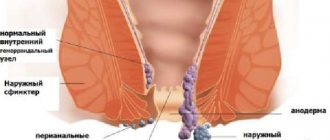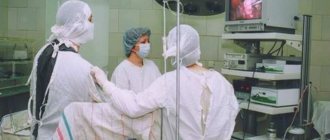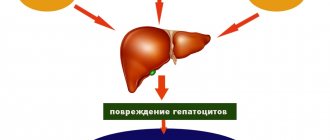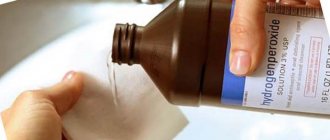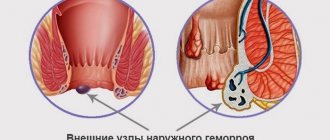In many coloproctology clinics in Russia, such a minimally invasive method of treating internal hemorrhoids as ligation of hemorrhoids with latex rings is becoming increasingly widespread. To perform it, a special mechanical or vacuum device is used, which allows you to cast a latex rubber ligature.
This treatment method has become popular among doctors and patients due to its simplicity and effectiveness. It can be used among a wide group of patients, including among those patients who are contraindicated for radical surgery or other minimally invasive methods of eliminating hemorrhoids.
Indications
The further effectiveness of treatment using the method of ligation of hemorrhoids largely depends on the correct determination of the indications for its implementation. To do this, the proctologist must prescribe a comprehensive set of diagnostics to the patient and clearly determine the stage of hemorrhoids.
Indications for performing ligation of hemorrhoids are the following clinical cases:
- II-III stage of hemorrhoids;
- Stage IV of the disease, accompanied by prolapse of nodes (in the absence of external hemorrhoids).
The procedure can be performed without the use of general anesthesia or spinal anesthesia, and this significantly expands its indications among groups of patients for whom these types of anesthesia are contraindicated. That is why the treatment of hemorrhoids during pregnancy, in the presence of contraindications to ligation with latex rings, can be carried out using this method.
What is the essence of the operation?
The technique is generally simple. Using a ligator, a latex ring is applied to the hemorrhoid. This flexible ring ties the neck of the node, which disrupts its further blood supply. Therefore, this area is dying off. Over the course of several days, the nodule leaves the body on its own along with feces.
If hemorrhoids have developed to the third stage, then it will not be possible to cure it at once. During one operation, it is allowed to apply a ring only to one or, in extreme cases, two nodes. The next procedure can be scheduled only two weeks after the previous operation. This condition is mandatory in order to prevent stress on the vascular system in the intestinal cavity and minimize the risk of hemorrhage.
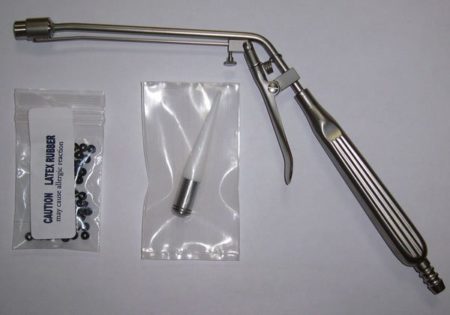
Ligator and rings
How to prepare for the procedure?
Before ligation with latex rings, the patient must undergo a standard examination by a proctologist and such additional research methods as blood tests (biochemical, clinical) and Doppler ultrasound of the rectal vessels. After this, the doctor can determine the tactics for further preparation of the patient, taking into account the research results.
The standard procedure for preparing for ligation of hemorrhoids with rings without other concomitant diseases is simple, and the patient can perform it independently (if necessary, a cleansing enema will be performed in a medical institution).
It includes the following activities:
- Two days before the procedure, the patient is recommended to exclude from the diet foods that can cause constipation: rice, baked goods, pomegranate juice, etc.
- The day before the ligation, it is necessary to cleanse the intestines: for this, the day before you can use laxatives (Flyta or Fortrans) or perform a cleansing enema 5-6 hours before the procedure (you must make sure that all the water introduced into the intestines comes out) .
- The day before, the patient should shave the hair in the anus and perineum area.
- Dinner before the procedure should take place before 18:00. It is better that it consists only of broth and sweetened tea.
If necessary, the scheme of measures can be supplemented by the prescription of anticoagulants or temporary withdrawal of various medications that the patient takes constantly.
How is the procedure performed?
The procedure for ligating hemorrhoids with rings is carried out on a proctological or gynecological chair. Depending on the clinical case, the doctor may ask the patient to take a position “lying on the left side” with the legs pressed to the stomach or “lying on the back” with the legs thrown back on special supports. Next, the proctologist inserts an anoscope into the lumen of the rectum and fixes it so that the hemorrhoidal node is located in the lumen of the device.
After completing these preparatory manipulations, the procedure can be performed in two ways:
- mechanical ligator;
- vacuum ligator.
The procedure for a proctologist when using a mechanical ligator is as follows:
- The device is inserted into the anoscope.
- The knot is grabbed with a special clamp and pulled through the head of the ligator.
- The doctor presses the trigger, and a latex ligature is thrown onto the stem of the knot.
- After this, the place where the ligature is applied is checked: it should not involve nearby tissues that are located below the serrated edge.
Typically, this ligation technique is used for nodes that have clear boundaries and a well-defined stalk. The procedure takes about 7-10 minutes.
The procedure for a proctologist when using a vacuum ligator is as follows:
- A vacuum ligator device is connected to the hemorrhoidal node, which is connected to a special suction device.
- When the suction is turned on, the doctor closes the hole located in the head of the vacuum ligator with his finger and the unit is sucked into the head by vacuum.
- After some time, a latex ligature is thrown onto the knot.
- The doctor removes his finger from the hole on the head and, after equalizing the pressure in the device, removes the ligator from the anoscope.
Unlike the procedure performed with a mechanical ligator, a vacuum device will allow the procedure to be carried out in cases where the hemorrhoid is not clearly defined and has a vague stalk.
After casting the ligature and removing the ligator from the anoscope, the doctor carefully removes the anoscope. After completing the procedure, the patient can get dressed and, having received the doctor’s recommendations, go home.
During one ligation session, latex rings can be applied to one or two nodes. This is explained by the fact that when trying to apply a ligature to three or more nodes, the patient may experience severe pain and other complications. If there is a need for ligation of multiple nodes, then the patient may need to perform several more of the same manipulations.
After bleeding caused by the latex ring, the hemorrhoidal node dries out and is painlessly removed out along with the feces. In the first two to three days after ligation, the patient may experience minor pain, which is eliminated by taking conventional analgesics (Diclofenac, Nurofen, etc.), or a sensation of a foreign body in the rectum, which soon goes away on its own.
What is latex ligation of hemorrhoids?
Ligation belongs to the category of minimally invasive operations in which the bases of hemorrhoids are compressed using latex rings. As a result, the blood supply to them stops, causing this small area of internal tissue to die.
Rings for surgery are made from a material resembling rubber in its properties and structure.
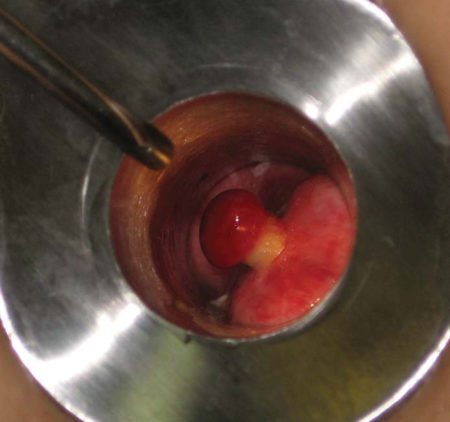
What does a node look like?
The procedure is performed for those patients who suffer from hemorrhoids of the third and second stages. At these stages of the disease, the nodes become quite large in size, lead to pain, and sometimes fall out of the anus, causing the patient a lot of inconvenience. In this case, symptoms such as irritation of the anus, itching, bleeding, burning, and pain occur.
Important! Ligation is carried out on a special gynecological chair, the patient should be in a supine position on his back, with his legs tucked towards the abdominal area, or lying on his left side. A device called an anoscope is inserted into the anus. Using the left hand, this device is fixed in such a way that the anorectal part is covered by the extreme side of its tube, and the hemorrhoidal growth is located directly in the lumen.
Possible complications
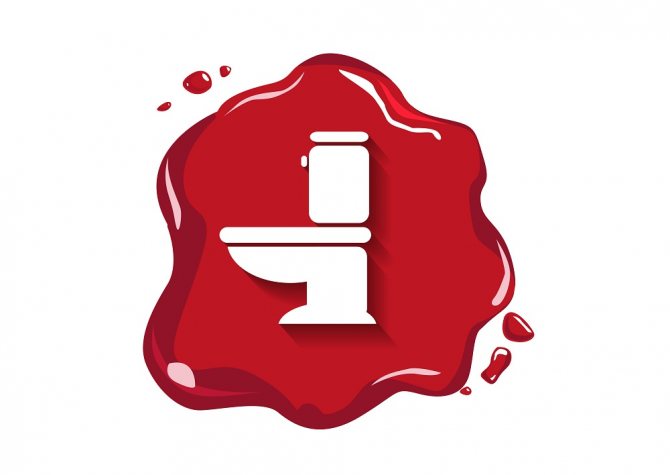
In most cases, complications after ligation of hemorrhoids develop rarely and occur as a result of an incorrectly performed procedure or the patient’s failure to comply with the rules of the postoperative period. These include:
- intense pain in the rectum - occurs when the ligature is applied incorrectly or when it is applied to more than two nodes;
- thrombosis of external nodes - provoked by the wrong choice of groups of patients for ligation, develops when the boundary between external and internal nodes is unclear;
- bleeding – occurs when the ligature ruptures due to the insufficient size of the latex ring, tightening the knot too tightly or the latex ring jumping off during straining during the first act of defecation immediately after the procedure due to improper preparation of the patient, heavy physical activity or lifting weights;
- infection of the rectum - provoked by infection during the procedure.
All of the above complications can be prevented if the patient follows all the doctor’s recommendations and carefully considers the choice of blade and proctologist for ligation of hemorrhoids.
Rehabilitation period
The recovery period after surgery does not last long. In a hospital setting, the patient is observed for one hour after the procedure. If the outcome of the operation is positive, then the patient leaves the clinic. During the first few days, slight minor pain and discomfort in the anus are observed.
During rehabilitation you must adhere to the following rules:
- Limit physical activity;
- Establish a complete balanced diet;
- Comply with all hygiene requirements;
- Follow a diet that makes it easier to pass stool.
It should be said that if the stool is too hard, it can cause bleeding. Therefore, during the rehabilitation period it is important to eat as much liquid food, fresh vegetables and fruits as possible.

Diet after surgery
After the operation, you should not forget about periodic visits to the proctologist for preventive measures.
Pros and cons of the procedure
The procedure for ligating nodes with latex rings has the following advantages:
- the ability to refuse radical surgery in cases where the patient complies with the doctor’s recommendations and the procedure was carried out correctly;
- no need for pain relief during the procedure using general anesthesia and spinal anesthesia;
- the ligation session can be performed on an outpatient basis;
- a patient whose profession does not involve heavy physical labor does not need to give up work for a long time;
- the possibility of using the technique in patients for whom radical interventions are contraindicated (for example, in the treatment of hemorrhoids during pregnancy);
- the procedure, when carried out correctly, does not cause complications;
- affordable price of treatment.
Provided that all indications for the procedure are observed and the patient follows all the doctor’s recommendations, the node ligation procedure has the following disadvantages:
- short-term sensation of a foreign body in the rectum and minor pain, which can be eliminated independently or with the help of non-narcotic analgesics;
- slight bleeding from the rectum during the first act of bowel movement.
Medical animation on the topic “Latex ligation of hemorrhoids”:

